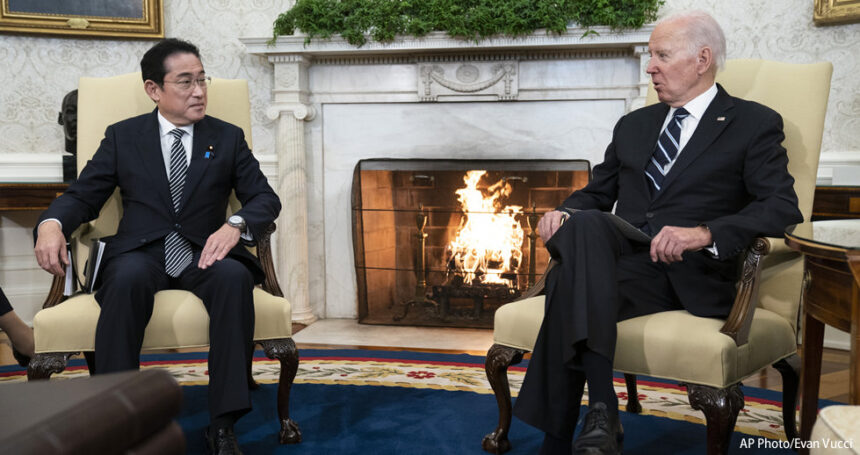Summary by Geopolist | Istanbul Center for Geopolitics:
The commentary discusses Japan’s strategy to consolidate the credibility of extended deterrence, particularly in light of nuclear threats. Here are the key points summarized:
- Nuclear Threats and Japan’s Response:
- Russia’s nuclear threats during its invasion of Ukraine have raised concerns in Japan and South Korea about the reliability of U.S. nuclear deterrence.
- Japan is strengthening its deterrence through missile defense and developing its own “deterrence by punishment” capabilities with stand-off missile systems.
- Military Enhancements:
- Japan is enhancing its missile defense in collaboration with the U.S., including developing a new interceptor missile.
- Japan is acquiring Tomahawk missiles and extending the range of its Type 12 surface-to-surface missiles.
- The goal is to bolster Japan’s counterstrike capability and fill the gap left by the U.S. due to the Intermediate-Range Nuclear Forces (INF) Treaty.
- Coordination and Capabilities:
- Japan and the U.S. need to integrate their military assets across all domains (maritime, air, cyber) to maintain operational effectiveness.
- Ensuring sufficient maritime and air capabilities to limit China’s strategic operations, particularly in the Taiwan Strait, is crucial.
- Diplomatic Initiatives:
- Japan must deepen security cooperation with South Korea, Australia, Southeast Asian nations, and India to counter China’s assertiveness.
- Engaging China and North Korea in strategic dialogue is important for crisis management and threat reduction.
- Enhancing multilateral relations in security, diplomacy, and economics can dissuade China from coercive behavior.
- Strategic Dialogue and Arms Control:
- Japan and the U.S. should strive for strategic dialogue with China to prevent misinterpretations that could escalate conflicts.
- Integrated strategic coordination between Japan and the U.S. on nuclear policy is necessary to avoid policy gaps and ensure the credibility of extended deterrence.
This approach aims to strengthen Japan’s deterrence posture both militarily and diplomatically, ensuring stability in the face of regional threats.
Read the full article below.
Shaken Confidence in Extended Deterrence
Russia’s invasion of Ukraine has given rise to the need for more in-depth discussions of the role of nuclear weapons in Japan’s security, both in terms of the perceived threat posed by nuclear weapons and the effectiveness of the Japan-US alliance’s extended nuclear deterrence.
The deployment of nuclear-capable missiles by Russia in its invasion of Ukraine, coupled with suggestive indications of potential nuclear weapon use, has heightened awareness surrounding scenarios where a nuclear-armed nation seeks to assert dominance in a conflict by insinuating the employment of nuclear arms against a neighboring country. East Asian states have perceived the looming threat of a scenario involving actual employment of nuclear weapons against them, alongside the potential for more assertive actions by nuclear-armed states operating under the “nuclear shadow.”
As the likelihood of nuclear threats has escalated, there have been growing voices in Japan and South Korea, both non-nuclear-weapon states, calling for greater scrutiny of the credibility and reassurance that the United States offers through its extended nuclear deterrence commitments, which are vital for both nations in countering nuclear threats. In Japan, momentum has been building, particularly among conservative politicians following the lead of the late Prime Minister Shinzo Abe, for the pursuit of nuclear sharing with the US. The public tends to support discussions on nuclear sharing, but they remain cautious in taking steps toward nuclear sharing, according to a poll by the Sankei Shimbun. Meanwhile, in South Korea, support for developing a nuclear arsenal has seen an upswing. According to a poll conducted by the Chicago Council on Global Affairs and the Carnegie Endowment for International Peace, approximately 70% of South Korean respondents supported their country having its own nuclear arsenal.
The debates in the two countries on how to ensure the credibility of extended nuclear deterrence have once again demonstrated the need to consider two aspects: the military utility of extended deterrence against security threats and the political effect of reassurance on the policy makers and citizens of allied countries.
Efforts to Enhance Extended Deterrence
To enhance the military effectiveness of extended deterrence, it is first necessary to assess the threats that the US’s allies face, understand the utility and limitations of US nuclear deterrence in dealing with those threats, and build a deterrence architecture that appropriately combines nuclear forces with conventional forces as well as cyber, ISR, and other assets.
On a strategic level, China has been augmenting its nuclear warhead count, with estimates projecting a total of 1,000 warheads by 2030. There will be more missiles equipped as Multiple Independently-targetable Reentry Vehicles (MIRVs) that can be launched from both silos and mobile platforms, heightening US vulnerability.
On a sub-strategic level, China possesses the capability to neutralize bases in Japan and Guam using intermediate-range ballistic missiles and cruise missiles, effectively employing Anti-Access/Area Denial (A2/AD) strategies to inhibit US military deployment in the region. Meanwhile, North Korea has consistently enhanced its nuclear capabilities by advancing its missile technology and operational prowess. The nation is developing what is termed “maneuverable tactical nuclear” capabilities and has integrated nuclear weapons into its war-fighting arsenal on the Korean Peninsula.
In light of these developments, Japan needs to strengthen its “deterrence by denial” and counterstrike capabilities to offset the offensive prowess of its adversaries, with a special focus on trimming adversaries’ second-strike capabilities. Japan and the United States have already initiated the joint development of a new interceptor missile to bolster their missile defense systems and complement ongoing endeavors to amplify deterrence by denial. Japan has started to build its counterstrike capability, beginning with the procurement of Tomahawk missiles from the United States, and it is also planning the acquisition of standoff missile capabilities by extending the range of existing Type 12 surface-to-surface missiles (SSM) . These weapons will also feature an up-to-date command (UTDC) link that enables the missiles to obtain real-time target updates during flight. Having been a party to the Intermediate-Range Nuclear Forces (INF) Treaty with the former Soviet Union, the United States lacks intermediate-range missiles to incorporate into its regional escalation ladder, resulting in a power vacuum. The long-range strike capability of Japan’s conventional warheads stands to fill this gap. Enhancing Japan’s counterstrike ability will further elevate the threshold for adversaries to initiate an attack. While Japan is accelerating its acquisition of stand-off missile capabilities, Japan and the United States will have to live with vulnerabilities until they close the gap with China, which already possesses intermediate-range missile capabilities.
It is also necessary to ensure asymmetric advantages at chokepoints in China’s operations by integrating and operating assets in all domains, including maritime, underwater, air, and cyber, so that China cannot achieve its strategic objectives in a sustained manner. In particular, Japan and the United States should ensure they maintain sufficient maritime and air capabilities to limit China’s ability to carry out logistical supply operations across the Taiwan Strait.
Second, Japan and the United States need to collaboratively build the capacity to effectively operate their assets. For instance, executing US military operations and providing support in contingencies involving Taiwan or the Korean Peninsula would prove extremely challenging without the support and joint action of Japan. It is crucial to proactively conceptualize the roles that Japan and the United States would undertake in scenarios where nuclear weapons, inclusive of nuclear threats, might be employed.
From China’s viewpoint, driving a wedge between Japan and the United States could serve as an effective strategy to diminish US responsive capabilities in such contingency scenarios. It is plausible that nuclear threats against Japan could be employed to achieve this objective, dissuading Japan from conducting joint operations with the United States.
Addressing such risks necessitates the fortification of Japan-US coordination and decision-making mechanisms within the framework of US-Japan extended deterrence. Regularly conducted Extended Deterrence Dialogues (EDD) between Japan and the United States foster a shared understanding and trust among policymakers. Additionally, an Alliance Coordination Mechanism (ACM) has been established. Building on this foundation, the alliance should contemplate scenarios involving the use of nuclear weapons in integrated multi-domain situations such as contingencies on Taiwan or the Korean Peninsula. It is imperative to establish standardized procedures for information sharing regarding the US’s use of nuclear weapons and to explore mechanisms for joint decision-making and responsibility-sharing concerning nuclear weapon employment.
Such an augmentation of the alliance’s operational posture would bolster the confidence of politicians and the broader society in the alliance, contributing to enhanced reassurance. The bedrock of successful alliance operation is steadfast political support.
Diplomatic Efforts
Beyond making robust the deterrence architecture of the US-Japan alliance, it is essential to deepen and cement security cooperation with South Korea and Australia as well as with Southeast Asian nations such as the Philippines and with India, whose security interests are undermined by China’s assertive behavior. There should be a concerted effort to enhance multilateral relations encompassing security, diplomacy, and economics to dissuade China from engaging in such behavior.
China should be kept from altering the status quo by force by making its strategic calculations more complicated and getting it to recognize that its pursuit of strategic goals through coercive measures would prove excessively costly. This can be achieved by supporting capacity-building in neighboring countries and reinforcing their resolve through strengthened political relations. It is imperative to acknowledge that such efforts will not solely focus on “building the capacity” of neighboring nations. These initiatives should contribute widely to the region’s sustainable growth and stability, extending beyond merely establishing a deterrence posture.
Pursuing dialogue with China and North Korea also makes sense from the perspective of threat reduction in the medium to long term. Although China has shown no interest in arms control and is pursuing military expansion for the time being, Japan and the United States should strive to convince China that arms control incorporates the elements of crisis management and confidence-building and serves all stakeholders’ interests. In the midst of a confrontation between the United States and China, it is necessary to have US-China strategic dialogue in order to avoid a situation in which both sides misread the signals that each other’s actions send, leading to unintended escalation of conflict (i.e., to ensure “crisis stability”).
Furthermore, in a situation where the stability of the US-China strategic relationship is inseparable from the regional stability of the Indo-Pacific and where the deterrence architecture also integrates the assets of non-nuclear allies such as missile defense systems, ISR, and conventional strike capabilities with medium-range missiles, the credibility of US extended deterrence in Japan could be significantly damaged if Japan is perceived as being marginalized in the US-China strategic relationship. Therefore, systematic and integrated strategic coordination dialogue between Japan and the United States on nuclear policy, covering topics ranging from deterrence and arms control to disarmament and nonproliferation, is necessary to avoid policy gaps between the two countries. Such dialogue would also function as a sustained coordination mechanism allowing Japan and the United States to convey messages to China and North Korea with one voice.
Conclusion
It goes without saying that extended deterrence arrangements with the United States are essential to Japan’s security and need to be strengthened. What is required now is an action plan the US and Japan, in cooperation with other partner countries, can swiftly implement to build assets comprising deterrence architecture, a coordination mechanism for the US-Japan alliance to effectively operate assets optimized for the threat landscape, and a solid political foundation. These efforts will be important to ensure the credibility of extended deterrence and prevent China and North Korea from believing that changing the status quo by force is feasible. It will also be essential that the United States, Japan, and other partner countries send closely coordinated and unified signals to China and North Korea to ensure that the pursuit of stability at the strategic level between the United States and China does not create more room for coercive behavior by China at the regional level in East Asia. At the same time, it will be necessary to engage in diplomatic efforts through strategic dialogue with China and North Korea to ensure crisis stability and build confidence that will lead to future arms control.
By: AKIYAMA Nobumasa is a professor at Hitotsubashi University.







